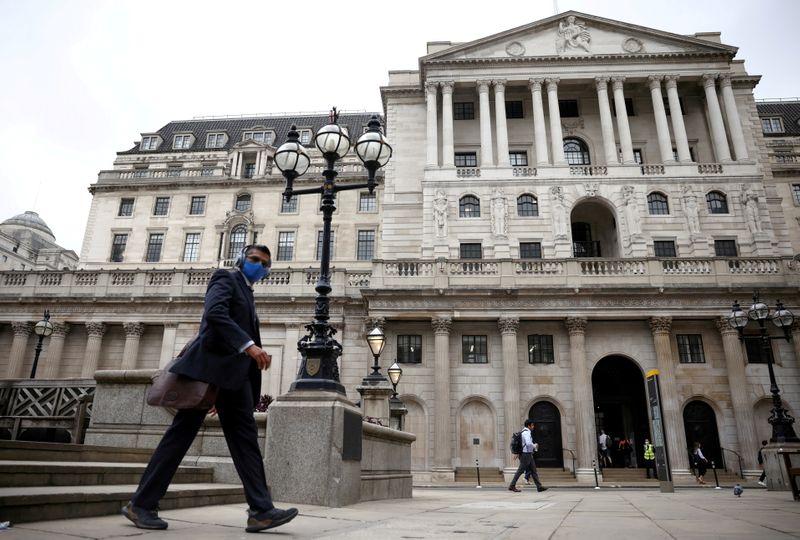BoE set to keep full-speed stimulus despite split over inflation risk
4/4 © Reuters. FILE PHOTO: A person walks past the Bank of England in the City of London financial district, in London, Britain, June 11, 2021. REUTERS/Henry Nicholls 2/4 By William Schomberg
LONDON (Reuters) – The Bank of England looks set to keep its stimulus running at full speed next week despite two policymakers breaking ranks to suggest that its nearly 900 billion pound ($1.2 trillion) bond-buying scheme might have to end early as inflation speeds up.
Britain’s economy is rebounding quickly from its almost 10% crash of 2020, when the country suffered a higher COVID-19 death toll and longer lockdowns than most other nations.
With consumers back in shops, bars and restaurants and fuel prices leaping as the global economy fires up, inflation has sped past the BoE’s 2% target and is on course to surpass 3%.
Many investors are betting the BoE will raise interest rates before the U.S. Federal Reserve, even though the U.S. economy has already recovered its pre-pandemic size, unlike Britain’s.
Two BoE rate-setters – Deputy Governor Dave Ramsden and Michael Saunders – have said the time for tighter policy might be nearing, raising the prospect of the BoE curtailing its bond-buying programme sooner than planned.
But colleagues have signalled they think the bigger risk would be to stop the bond-buying programme before its scheduled end in late 2021. That could hurt the still incomplete recovery in the world’s fifth-biggest economy.
Finance minister Rishi Sunak is phasing out furlough payments along with other parts of his pandemic safety net, and a recent slowing of COVID-19 cases could prove fleeting.
“I think it will remain appropriate to keep the current monetary stimulus in place for several quarters at least, and probably longer,” Monetary Policy Committee member Gertjan Vlieghe said on Monday.
INFLATION SIGNALS
Key to the BoE leaving the stimulus programme unchanged is its view that the jump in inflation will prove short-lived.
In May, the BoE said it expected consumer price inflation would peak at about 2.5% in late 2021 although it was then forced to raise that to above 3% in an interim forecast in June.
The new quarterly projections due on Aug. 5 are likely to see a new peak of 3.5%, which would nudge up the BoE’s closely watched forecasts for inflation in two and three years’ time to its 2.0% target, according to economists at HSBC.
That would be taken by investors as an implicit backing of recent market pricing for a May 2022 hike of 15 basis points taking Bank Rate to 0.25%, up from its all-time low of 0.1% now, and a further 25 basis point hike a year later, they said.
“This is more tightening and sooner than was expected in May, when the first 15 basis point move was not priced until early 2023,” HSBC economist Elizabeth Martins said.
Other economists expect the BoE to raise rates in the second half of 2022 or only in 2023.
HOW TO TIGHTEN?
Investors are also waiting for the BoE to publish new guidance on how it would sequence raising interest rates with shrinking its bond-buying programme, either by not reinvesting the cash from maturing bonds or by actively selling bonds.
Vlieghe said on Monday that the BoE would publish its review “soon” but like other MPC members he declined to give precise details on any timing.
Deutsche Bank (DE:DBKGn) economist Sanjay Raja predicted the BoE would announce its strategy next week and say that it was lowering the Bank Rate threshold at which it would start to unwind its balance sheet to 0.25% – much lower than the existing 1.5% trigger – or simply scrap the threshold altogether.
That would allow the BoE to crack on with the task of shrinking its massive balance sheet, possibly in mid-2022.
“Unlike the previous tightening, the MPC will target the Bank’s balance sheet more so than the policy rate,” Raja said.
($1 = 0.7239 pounds)











 Bitcoin
Bitcoin  Ethereum
Ethereum  Tether
Tether  XRP
XRP  USDC
USDC  Lido Staked Ether
Lido Staked Ether  TRON
TRON  Dogecoin
Dogecoin  Cardano
Cardano